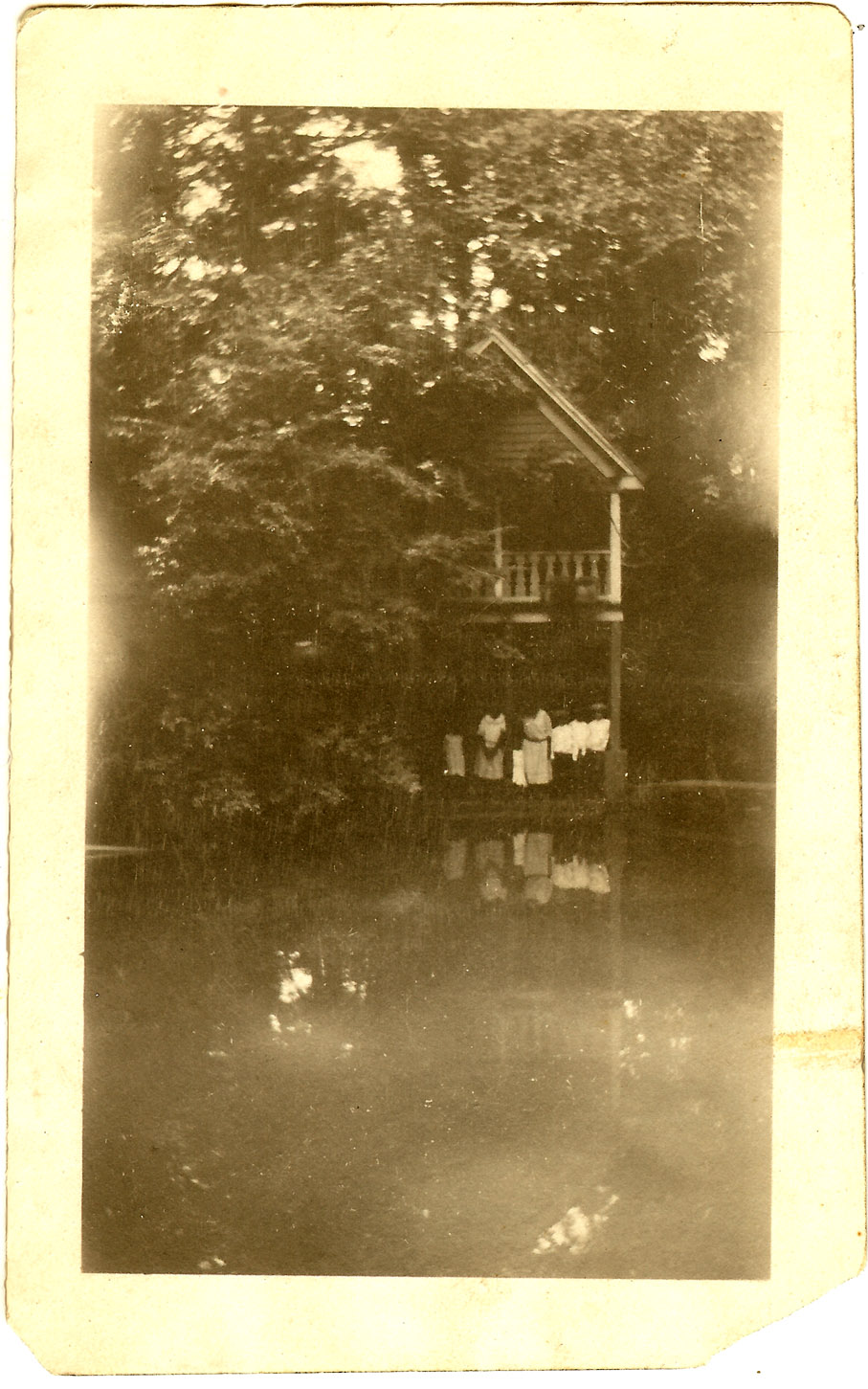
My father and his brothers and perhaps a sister and some cousins and an aunt. My grandfather took his family back to his home town, Athens, Tennessee every summer for many years to visit his brother and his brothers family and his mother.


My father and his brothers and perhaps a sister and some cousins and an aunt. My grandfather took his family back to his home town, Athens, Tennessee every summer for many years to visit his brother and his brothers family and his mother.


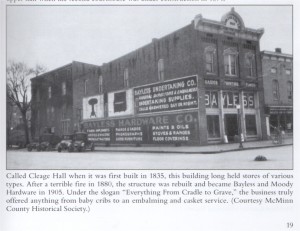
For this year’s April A-Z Challenge I am blogging a series of sketches about the free people formerly enslaved on the Cleage plantations in Athens, Tennessee and their descendents. Click on any image to enlarge. Click on links for more information.
William Henry Cleage was born free on December 4, 1866 in Athens, Tennessee. His mother was Adeline “Addie” Cleage and his father was Nelson Cleage. His mother married Edmund Sherman shortly after William was born and for over 33 years of his life he used the name William Henry Sherman and was listed in the censuses along with the couples other children as a son of Edmund Sherman.
Until they died Williams grandparents, Henry and Jane Cleage, lived next door. William and his siblings all attended school and learned to read and write. In 1866, the Methodist Church along with the Freedman’s bureau started a school for black children in Athens. I was unable to find out much more but this is the school they probably attended. Grandfather Henry and stepfather Edmund worked as laborers and the women of the family worked as laundresses from their own homes, when they had paid occupations. Eventually his widowed sister Belle and her two children moved next door on the other side. His sister Sallie and her two children lived with their parents, Edmund and Addie. William lived for many years in the multigenerational family home. All three of the households owned their homes free of mortgage.
In the 1910 Census, 45 year old Williams was identified for the first time as a Cleage and as the stepson of Edmund. The grandparents were dead. Addie, Belle and Sallie were all taking in laundry and all of Belle and Sallie’s children were attending school. By this time the Athen’s Academy was up and running and that was probably the school they attended.
William married Laura Hall on June 8, 1911. He was 44 and she was 22. Laura died eight years later on August 21, 1919 from influenza. She had been ill for thirty days. The Influenza Pandemic was sweeping around the world. In contrast to other forms of the flu, this type killed more healthy young adults than any other part of the population.
I do not know if they had any children. I tried to find Laura’s sister’s households for the 1920 Census, but so far I have not found them. In 1920 William was working as a porter at a hardware store in Athens. Laura’s 18 year old brother, Clarence Hall, was living with him and attending school. William was renting a house on King Street.
In 1930 William was boarding with Joe and Emma Melton, an older couple who lived on Chester Street. William was a truck driver for a hardware store.
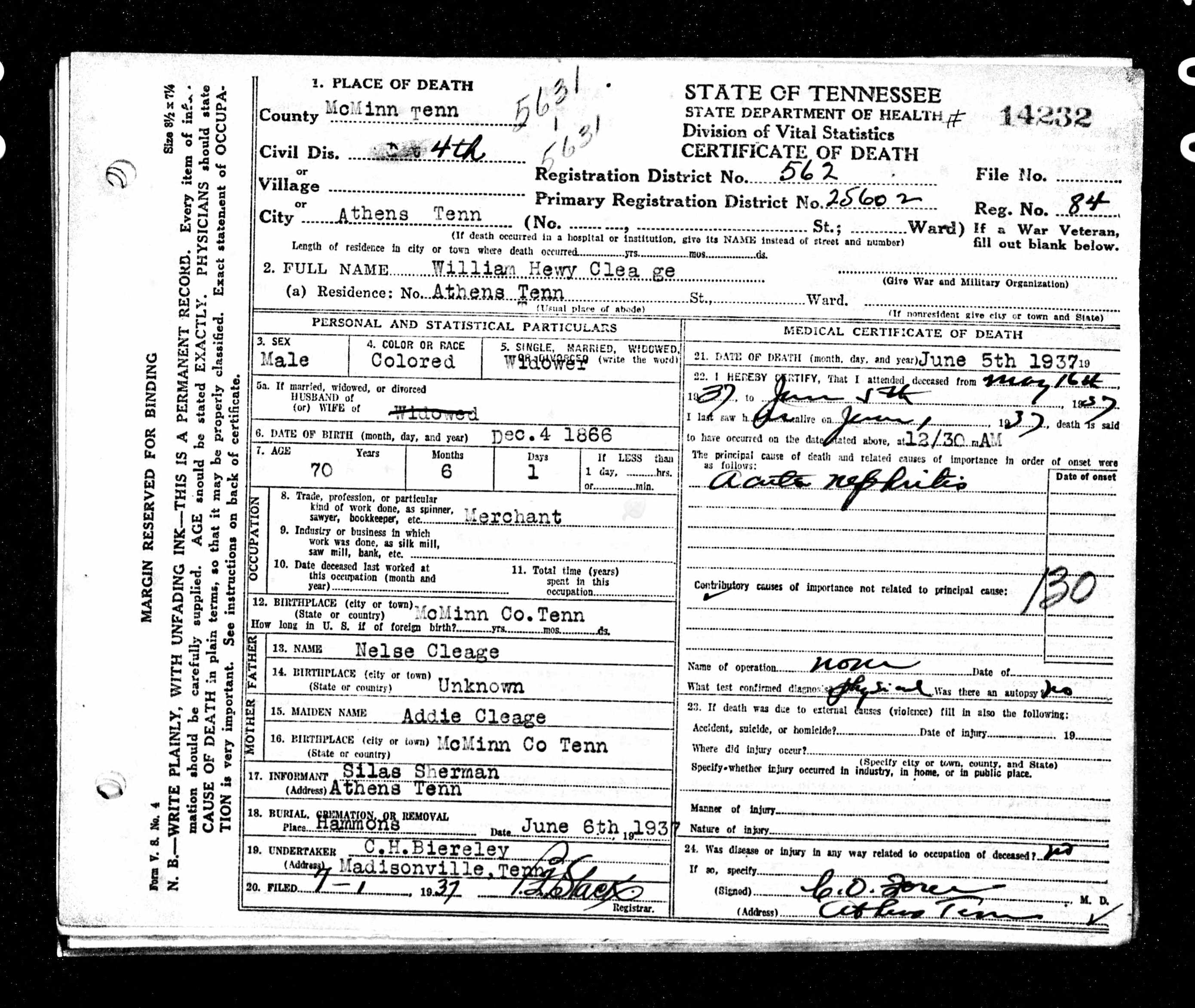
On June 5, 1937, William died of kidney failure. His occupation was listed as “Merchant”. He was 70 years old. The informant is listed as Silas Sherman. I wonder if they meant Sallie Sherman, William’s sister. Several names were misspelled on the death certificate – Nelson is spelled “Nelse” and Henry is spelled “Hewy”.

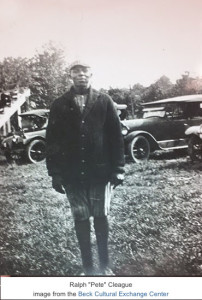
For this year’s April A-Z Challenge I am blogging a series of sketches about the free people formerly enslaved on the Cleage plantations in Athens, Tennessee and their descendents. Click on any image to enlarge.
Ralph “Pete” Cleage was born January 25, 1898 in Athens, Tennessee. He was part of the second generation of his family born free. The son of Florence Cleage and grandson of Jerry Cleage, he grew up surrounded by extended family. Ralph, his mother and his siblings, Harriett and William, lived with his Aunt Nellie Cleage Deadrick and her daughter Delia, until he was about 21. Florence was a cook and Nellie was a laundress. The children all attended school. Ralph completed three years of high school. He worked as a laborer and as a truckman for the railroad. Ralph was 5’11”, weighted 180 lbs and had dark hair and dark eyes.
Ralph’s mother Florence, died June 4, 1918 of typhoid fever. She was 40 years old. She was buried in Hammond’s cemetery. Ralph’s grandfather Jerry Cleage died the following year on March 28, 1919 of arteriolosclerosis. He was 92 years old.
The next year found Ralph playing baseball with the Knoxville Giants, a black baseball team. He played first base and later became a respected umpire. The players worked other jobs to support themselves as they did not make enough to live on. You can find more articles on Knoxville’s black baseball players at Old Knoxville Baseball by clicking the link.
Ralph married Carrie Sweat about 1934. He lived in Knoxville and eventually moved to Nashville where he continued his baseball career. He worked as a watchman and a laborer to supplement his income. You can see his Baseball Stats at this link. Here are a few articles from Mark D. Aubrey’s Old Knoxville Baseball page that mention Ralph Cleage. The Winston-Salem article is from www.newspapers.com
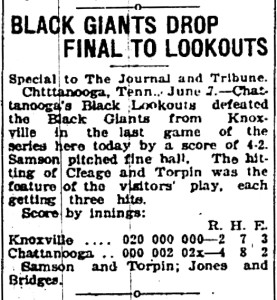
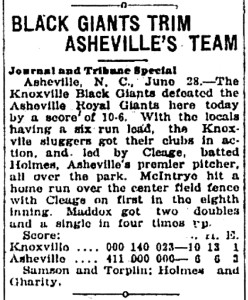
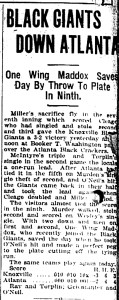
Ralph died on October 29, 1977. He was 79 years old. Because he died so recently, his death certificate is not available online. Ralph is buried in Crestview Cemetery, the largest black cemetery in Knoxville. Like many of the African American cemeteries I have found during this challenge, it started out well kept and went into a decline in the 1960s until it was covered in brush and weeds. A clean up effort started in 1990 and it is reported to be in much better condition now.
I finally was able to see a copy of my great grandmother, Anna Celia Rice Cleage Sherman’s death certificate. I had been searching for it for years, not realizing that her first name was “Anna”. It doesn’t have her parent’s names or tell where in Athens, Tennessee she is buried. What it did was to tell me when and where she died and to verify some of the information I already have.
My grandfather, Albert B. Cleage Sr was the informant, he provided the information. I thought his close friend, Dr. P.B. Gamble signed, but the initials are wrong.
She died on May 31, 1930 of Cerebral Apoplexy, a stroke, which she suffered on May 28, 1930. That would have made my Aunt Anna 6 years old, the age she told me she was when she saw her grandmother suffer a stroke while sitting at their kitchen table.
Great grandmother Anna Celia married Roger Sherman in Athens, Tennessee on April 25, 1897. He was 51 and she was 42. He was a carpenter and worked for himself. It was the second marriage for both of them. His 4 children were all grown and living on their own. She had 5 children. In 1900 the oldest daughter, Josie was married with two children and was sharing the house with Roger and Celia Sherman, as were three of her younger brothers (Henry, Edward and Albert) who were all students. Jake, the 2nd oldest, had been working in Knoxville as a waiter for several years.
Celia and Roger Sherman were living together in the 1910 Census, but by the time of the 1920 Census, Mr. Sherman was living with his daughter, Mamie Sherman Kennedy, in Winston Salem, NC. Later that same year he died. His body was also shipped back to Athens for burial in an unnamed cemetery.
Anna Celia lived in Athens with her son Charles Edward and his family in 1920. In 1924 he died. She moved to Detroit where her other three sons lived. In 1930 she is enumerated with my grandfather and his family. Several months later, she died.
On the death certificate, my grandfather says that he doesn’t know when she was born but guesses her to be about 65. He was 47 at this time. His oldest sister was 57. If their mother was 65, she would have been 8 when her daughter was born. She was old enough when Freedom came to remember her life on the Rice plantation where she was born. If only she could have written it all down. In the 5 censuses I find her, the date of birth is given as “about 1855”. She was closer to 75 than 65 when she died. He says that she was born in Tennessee. The information on the census records are split between Virginia and Tennessee. All agree her mother was born in Virginia.
What else do I want to find out about my great grandmother Anna Celia Rice Cleage Sherman? I want to know where she is buried. I want to find her in the 1870 Census and I want to find out her mother’s name and what plantation they came off of.
In my minds eye, I see a large stone grave marker in Hammonds Cemetery that said “Sherman”. I did not go up to it, just saw it across the grass. When I get back to Athens, I am going to go look at that marker and see if it has any other information on it. Not to mention looking at every other stone there.

I found this article today. It had a photo included but it was so dark it was impossible to see anything except that it was the same photograph that I had in my Cleage photos and often wondered what the occasion was. It was a program in honor of J.L. Cook, founder of the Athens Academy. I had no idea that my grandfather’s sister, Josie Cleage, was a member of the first graduating class. That is my grandfather below, on the far right wearing a white suit. You can read more about Dr. Cook here – The Church and School that Jake Built. Click to enlarge article and photos.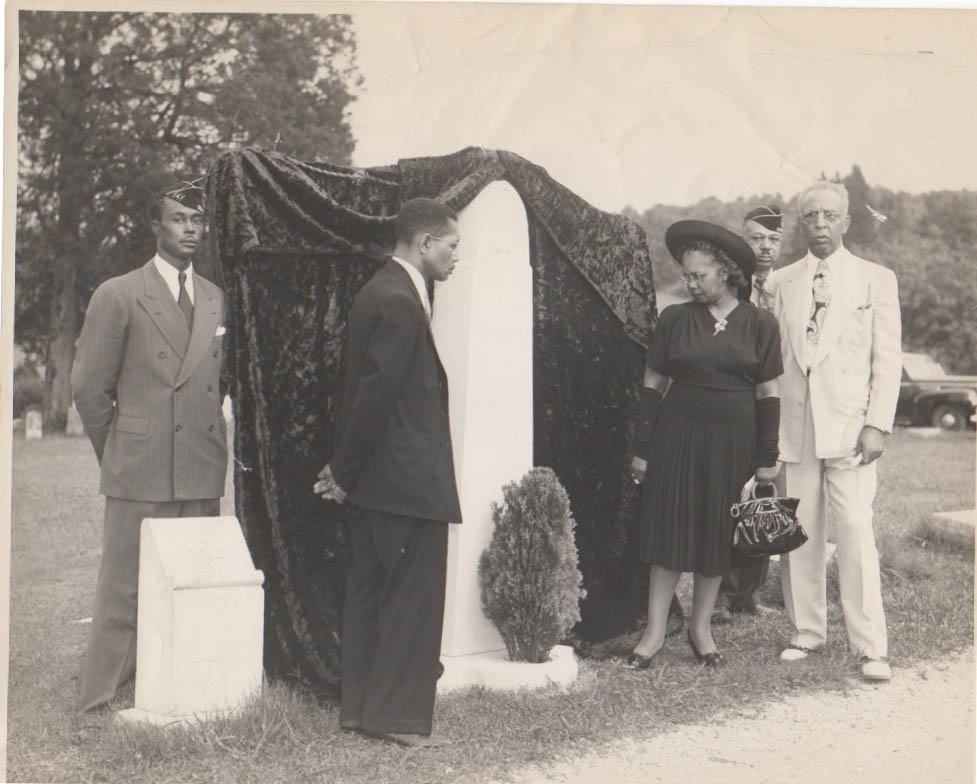
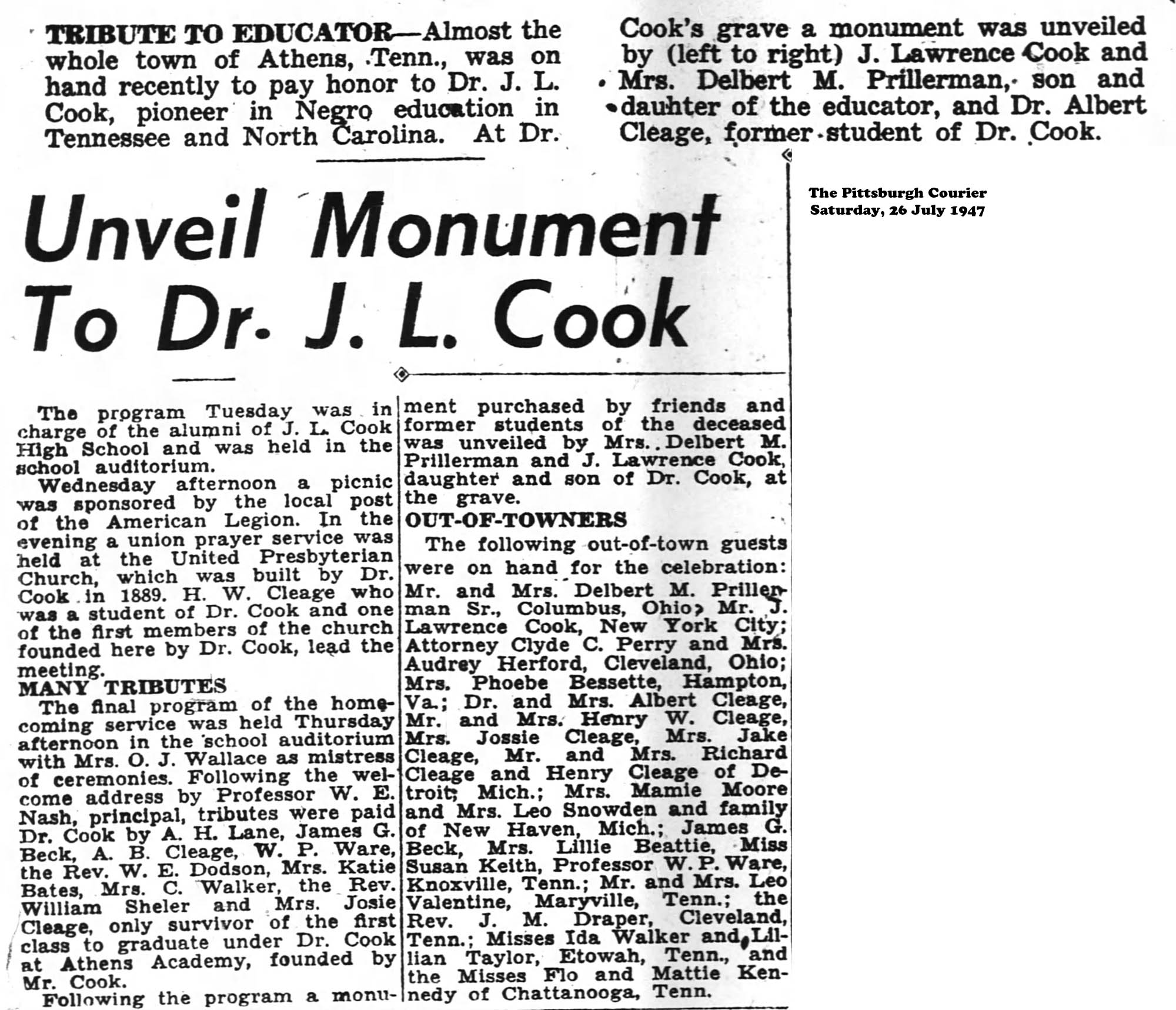
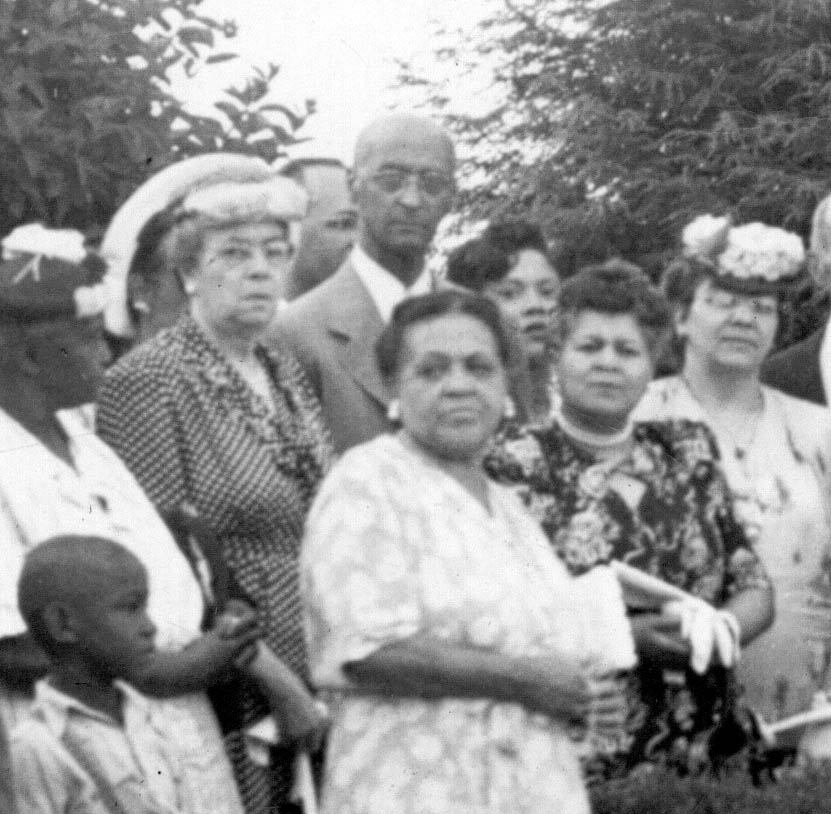


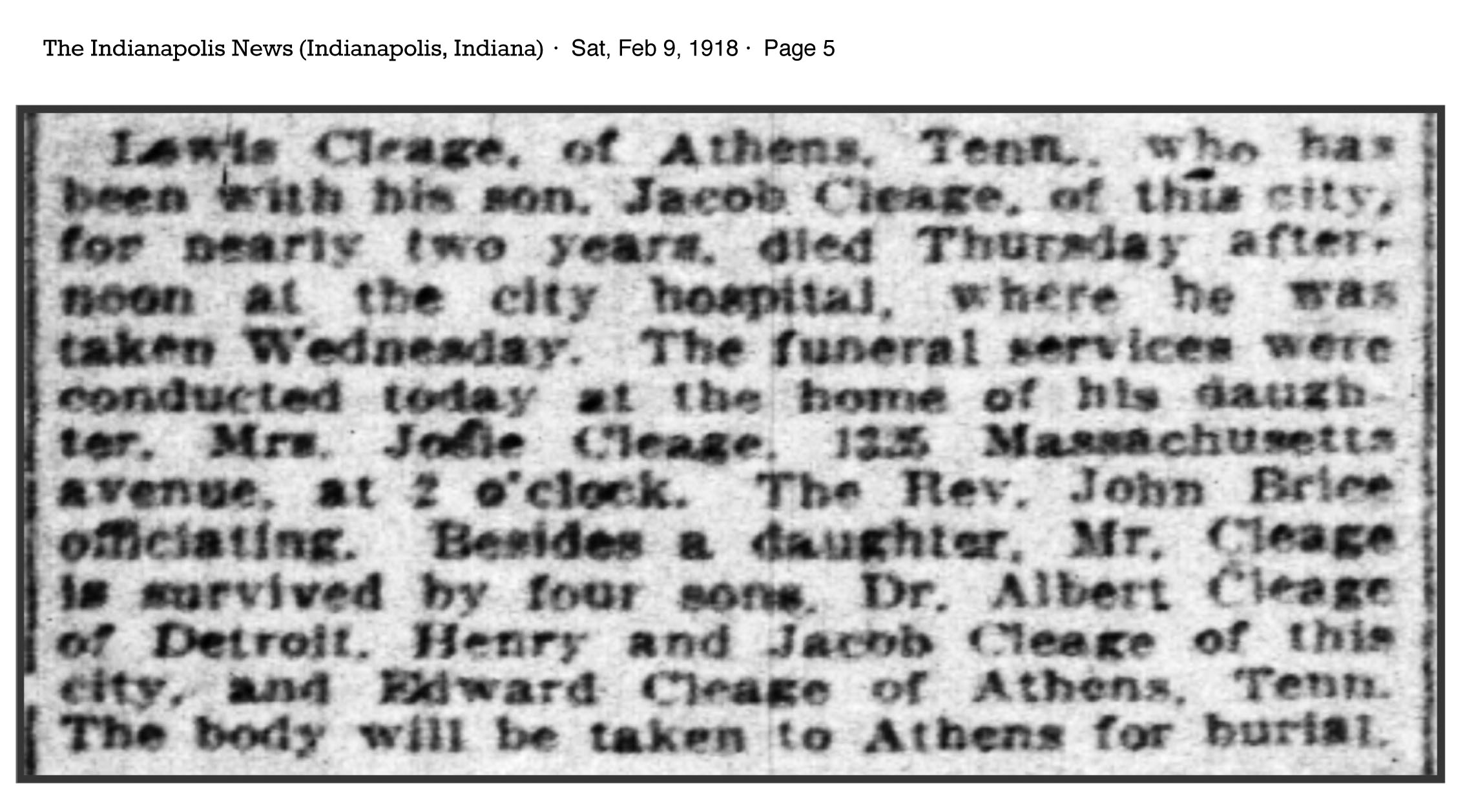
I recently received this obituary for my great grandfather Louis Cleage. I noticed several things. First, he was not taken to Athens for burial. He is buried in an unmarked grave in Crown Hill Cemetery in Indianapolis pictured here. He lived in Indianapolis for two years before his death. And I wondered, who was Rev. John Brice? Had he been pastor at Witherspoon United Presbyterian, the Cleages church? Was he from their hometown, Athens, Tennessee? Here is what I learned.
John Brice was born in 1878 in Knox County Tennessee the 7th of the nine children of Hampton and Harriett Brice. Exceptional for these times they owned their own land. Although they were illiterate, all of their children attended school and learned to read and write. John attended Knoxville College Normal, graduating in 1899. He finished the Baccalaureate program in 1904 and graduated from Knoxville Seminary in 1909. He met his wife Ella Hawkins there. My grandfather, Albert B. Cleage Sr. attended Knoxville College during this same time, graduating in 1906.
In 1910 Rev. John Brice was pastor of First United Presbyterian Church in Athens, Tennessee. He roomed one house over from my great grandmother Celia Rice Cleage Sherman and her family, which included her second husband Roger Sherman (who is listed as an architect for First United Presbyterian Church), son Edward and his wife and two children, along with eight year old grandson Richard. My grandfather, his two other brothers and his sister and her family were already living in Indianapolis, Indiana.
Brice wasn’t pastor in Athens very long. By 1912 he was married and pastor of Witherspoon United Presbyterian Church in Indianapolis, Indiana. My grandparents and my grandfather’s brothers were some of the founders of Witherspoon. Brice’s three youngest children were born in Indianapolis.
He served as a chaplain in France during WW 1. Following the war he taught and pastored in Alcoa, Tennessee. Alcoa was a company town set up by Alcoa Aluminum. They used cheap southern labor, black and white. When things fell apart as far as the vision that some of the professional black people on staff had hoped to implement, Brice moved to North Carolina to teach and work at the Palmer Memorial Institute, founded and run by his wife’s niece, Charlotte Hawkins.
Charlotte Hawkins Brown & Palmer Memorial Institute: What One Young African Could Do By Charles Weldon Wadelington, Richard F. Knapp
Rev. Brice died around 1960. A long time family friend and DNA relative has alerted me to John Brice’s death certificate on Ancestry.com. It also turns out that my dna cousin is related to John Brice’s grandson, Guion Stewart Bluford Jr.
Of his four children, three had careers in music. The youngest, Carol Brice had a career in opera. Johnathan and Eugene often accompanied her on the piano and also had careers of their own. Daughter Lolita Brice was an educator and married engineer Guion Stewart Bluford Sr. Their youngest son was Guion Stewart Bluford Jr, who was the first black astronaut, in spite of his high school counselor in the 1960s advising him to take up a trade because he wasn’t college material.
I hadn’t planned yesterday to go to Family Search and look for the Will of Alexander Cleage, but I did.
“I give and devise to my beloved wife Jemima Cleage for and during her natural life the following described Negro slaves – to wit: … Juda and her five children to wit: Charles, Angelen, Lewis, Laura and Frank… I also give and bequeath to her for her natural life a negro man called Frank the husband of Juda…”
30th day of May 1860 Alexander Cleage
Juda and Frank Cleage were my two times great grandparents. Their son Lewis Cleage was my great grandfather, my own grandfather Albert B. Cleage’s, father. I have several other documents that trace them through slavery – a letter to the overseer in 1838 and a bill of sale that mention Frank in 1852, a marriage record for Frank and Juda Cleage in 1866 and the 1870 census, Lewis’ death certificate in 1918.
By the time the will was probated 1 March 1875, my people had been free for 10 years.
These records give me a bare bones outline of their lives. I have no photographs, no stories. Nobody’s memories. These bones and their names. I read the will over and over until I felt it inside of me. I saw my cousins faces, my children’s faces. All descended from these two people – Frank and Juda Cleage and their son, Lewis Cleage. I wish I could see their faces. I wish I knew their stories. I wish someone had shared memories. One thing I know is that I will tell the parts of their stories that I can piece together and I will say their names. Frank Cleage born 1816 in North Carolina. Juda Cleage born 1814 in Tennessee. Lewis Cleage born 1852 in Athens Tennessee and died 1918 in Indianapolis, Indiana.
You can see a copy of the will here: Last Will and Testament of Alexander Cleage
You can see a copy of Elijah Hurst’s Will leaving my enslaved great great grandmother Juda Cleage to his daughter, Jemimah Hurst Cleage Elijah Hurst’s Will-1848

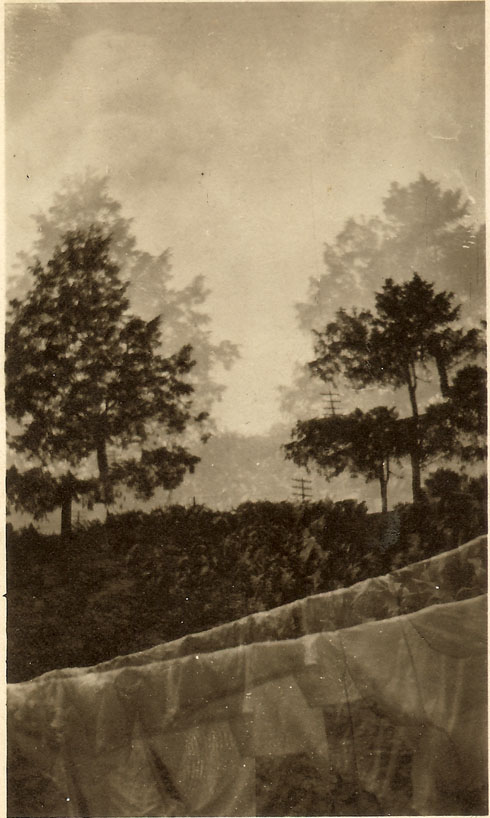 This is a double exposure that I found in my Cleage photos. It was probably taken by my grandfather since my father was only about 8 or 9 years old. It is in the batch with other photographs taken in Athens, Tennessee around 1919. There seem to be sheets on a clothesline in the foreground. Athens is in the foothills of the Great Smokey Mountains and was my Grandfather Albert B. Cleage Sr’s hometown. He took his family back for a visit most summers when they were growing up.
This is a double exposure that I found in my Cleage photos. It was probably taken by my grandfather since my father was only about 8 or 9 years old. It is in the batch with other photographs taken in Athens, Tennessee around 1919. There seem to be sheets on a clothesline in the foreground. Athens is in the foothills of the Great Smokey Mountains and was my Grandfather Albert B. Cleage Sr’s hometown. He took his family back for a visit most summers when they were growing up.
There are links to other photos from trips to Athens below.
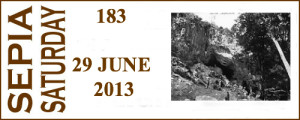
In 1946 there was a pitched battle between the corrupt local government and WW2 veterans in Athens, Tennessee. My paternal grandfather was from Athens and I had cousins living there. My cousin, Beatrice Cleage Johnson, wrote a description of that night. It is pretty much the same story as told in the video except that the man shot in the back in the video is white and in the memoir he is black. The video is embedded after Beatrice’s memory of the event.
______________________
I will never forget the day this occurred. The G.I.s had returned to McMinn County and were faced with the same political machine they had left and were determined to do something about it to rid McMinn County of machine politics.
Paul Cantrell was sheriff at this time and he loved two things: money and power. He ruled McMinn County with an iron hand. He was tied to the “Crump Machine,” which was the political boss of the State of Tennessee during the 30’s and 40’s.
Cantrell used deputies who had served prison terms for gambling and bootlegging.
Election day (August 1, 1946) in Athens was a war of “ballots and bullets.” We lived only a few blocks from the jail, where the votes were counted. There were around nine thousand residents in Athens. Of these, seven hundred Negroes played a small part in the election, but they formed a balance of power. Most of the Negroes were Republican and received threats and repeated arrests from the Democrats. The election of the sheriff was very important in McMinn County. The Republicans tried to unseat the Democrats. The pressure of a world war and the return of veterans from World War II had great influence on the politics of the county.
Election day in Athens was like an armed camp. When voters came to the polls, the Cantrell Machine was staging demonstrations, strutting around with pistols and black jacks. Deputy Sheriff Pat Mansfield, used thugs from other states as deputies. The voting was heavy at the polls. The GI’s were “poll watchers.”
Trouble started at the polls when Tom Gillespie, an elderly Negro, tried to vote and was slugged by the deputies. He was shot in the back by another and was taken to the hospital. G.I. poll watchers were held prisoners at the polls. No one in Athens slept that night.
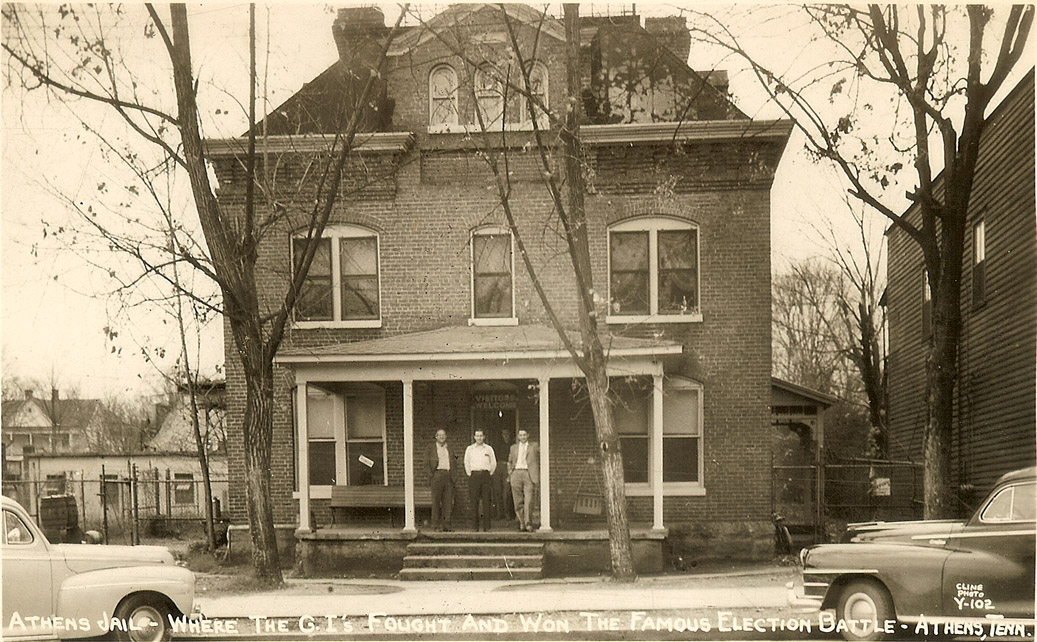
The votes were being counted at the McMinn County Jail. The G.I.’s stood at the door of the jail and demanded the ballot boxes and the release of the G.I. prisoners.
The battle had begun. The G.I.’s blasted the jail with dynamite and bullets. The deputies were safe behind the walls of the solid brick jail. Cars were dynamited, turned over and filled with bullets. Picks and axes were also used to destroy cars.
The deputies finally surrendered at 3:30 in the morning with their hands up. Both Paul Cantrell and Pat Mansfield were able to escape from the jail, leaving their deputies behind to face an angry mob.
McMinn County was without law and order from the night of the election until the afternoon of the next day. I remember seeing men walking the streets with shotguns and rifles. I will never forget the morning after when everybody went to town to see the ruins. After this battle, the county soon settled down to ordinary life. Freedom of speech and the right to vote their way was given back to the people, but August 1, 1946, will never be forgotten.
McMinn County became a Republican county; however, Democrats also held offices in both the county and city and still do.
—Beatrice Cleage Johnson
Christmas and Early Childhood
by Juanita Cleage Martin
From the book “Memories to Memoirs”
My favorite toy was a big doll. In our day, dolls were stuffed with sawdust, and their heads and arms were made of plastic, not like plastic of today. I remember I left it outside and the rain ruined it and made puffed splotches like blisters. I cried, as I dearly loved this doll. My sister Bea was the doctor. She gathered wild purple poke berries and covered the places. I continued to carry and play with it until it finally tore to pieces.
1928-1940 Cuddles or Sally-kins, 14-27″ tall, composition head, arms, legs (some limbs are rubber), cloth kapok stuffed body, molded hair, tin flirty sleep eyes, with lashes, open mouth with upper & lower teeth, tongue, mama crier, wore an organdy dress, bonnet and rubber panties, (Little Sister has flannel diapers). Made by Ideal.